
Press Trust of India | Last Updated: March 12, 2016 20:37 (IST)
New Delhi: For better clarity on
change of control in mergers and acquisitions, the Securities and Exchange
Board of India (Sebi) on Saturday decided to launch a public consultation for
defining 'control' and proposed fixing 25 per cent voting rights as a
threshold.
In this regard, the market
regulator will initiate public consultation on bright line tests for acquiring
control in a listed entity.
The approval of the proposal by
Sebi's board comes against the backdrop of instances of ambiguity and concerns
over control in some listed entities.
During the meeting on Saturday,
the board approved the proposal for public consultation process regarding
"bright line tests for acquisition of control under Sebi (SAST)
Regulations, 2011".
The market watchdog will come out
with an illustrative list of protective rights that will not amount to
acquisition of control and grant of such rights will be subject to obtaining
public shareholders' approval.
"Considering the
international practices and the current regulatory environment in India, the
definition of control may be amended such that control is defined as the right
or entitlement to exercise at least 25 per cent of voting rights of a company
irrespective of whether such holding gives de facto control and/or the right to
appoint a majority of the non-independent directors of a company," the
release said.
Other options will also be
considered after the public consultation.
Currently, assessment of control
requires consideration of facts and circumstances of each case. As a result,
there have been multiple shades of opinion.
Besides, multiple regulators
apply the test of control from different perspectives resulting in ambiguities.
Under SEBI regulations, control
is based on certain defined principles rather than on rules and there have been
cases when a multitude of opinion gives rise to different assessments of
control over a listed company.
A bright-line rule or a
bright-line test generally refers to a simple and basic standard that can be
applied to remove ambiguity and resolve contentious issues.
In cases of mergers and
acquisitions, an acquirer or any other entity would be considered to be gaining
control of the target company if it fulfills the bright line tests with regard
to acquisition of voting rights, control over operations and influence in board
decisions.
There have been many cases,
including in the much talked about Jet-Etihad deal, when the issue of control
was debated a lot and it was felt that Sebi needs to put in place specific
guidelines defining bright lines to determine the control.
SEBI has received representations
from various investor groups and other entities, seeking some kind of guidance
with a view to providing more clarity on the definition of control and defining
bright lines on the same.
Fair trade regulator CCI
(Competition Commission of India) had first pointed out in its order on
Jet-Etihad deal that the various pacts between the two companies indicated
Etihad Airways' joint control over Jet Airways.
Story first published on: March
12, 2016 20:27 (IST)
http://profit.ndtv.com/news/market/article-sebi-to-define-control-proposes-25-voting-right-threshold-1286531